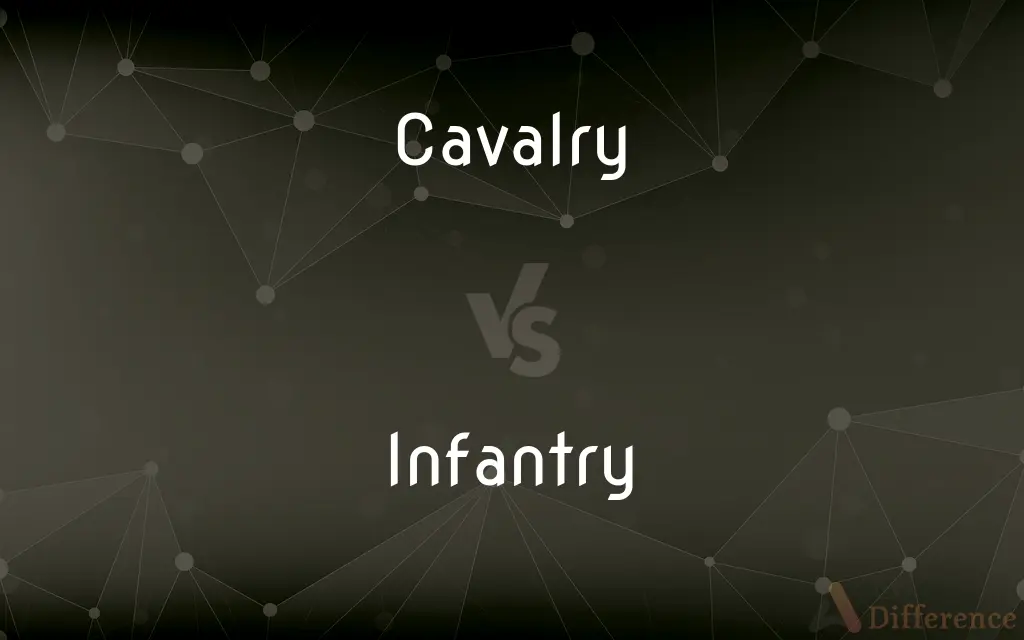Cavalry vs. Infantry — What's the Difference?
By Tayyaba Rehman — Updated on September 16, 2023
Cavalry refers to soldiers who fight on horseback or armored vehicles, while infantry are foot soldiers who fight on the ground.

Difference Between Cavalry and Infantry
Table of Contents
ADVERTISEMENT
Key Differences
Cavalry and infantry are fundamental units in military formations, each serving distinct roles. The cavalry traditionally consists of soldiers who ride horses into battle. Their mobility offers advantages in rapid movement, flanking, and reconnaissance. Modern cavalry has evolved to include units mounted on armored vehicles, still prioritizing speed and maneuverability.
Infantry, on the other hand, represents the foot soldiers who march and fight on ground. These soldiers often bear the brunt of frontline combat. They're trained for various terrains and close combat scenarios. Infantry remains the backbone of many armies, given their adaptability and the range of combat situations they can handle.
Historically, cavalry was seen as a prestigious unit because of the cost associated with maintaining horses and the equestrian skills required. Infantry, although equally vital, didn't have the same level of prestige attached. Yet, over time, as warfare tactics and technologies evolved, the lines defining the prominence of cavalry over infantry blurred.
Today, with the development of armored vehicles, tanks, and other mechanized units, the traditional horse-mounted cavalry has become less common. However, the terms persist, with "cavalry" often referring to units that prioritize speed and "infantry" those that emphasize ground engagements.
Comparison Chart
Definition
Soldiers on horseback or armored vehicles
Foot soldiers
ADVERTISEMENT
Mobility
High mobility
Limited to marching speed
Traditional Prestige
Seen as prestigious
Essential but less prestigious historically
Combat Range
Can cover larger areas quickly
Engages in close combat and holds positions
Modern Equivalent
Armored vehicle units
Ground troops with varied support
Compare with Definitions
Cavalry
Soldiers trained to fight on horseback.
The medieval king relied heavily on his cavalry for rapid assaults.
Infantry
Ground troops forming the core of an army.
The infantry was tasked with capturing and holding the hill.
Cavalry
Units prioritizing speed and quick engagements.
The general called in the cavalry to chase down the retreating foes.
Infantry
Soldiers trained to fight while on foot.
The infantry advanced steadily, holding their line against the enemy.
Cavalry
Military troops mounted on armored vehicles.
The cavalry swiftly moved to flank the enemy's defenses.
Infantry
Military units specializing in frontline engagements.
The enemy's infantry was formidable, consisting of seasoned soldiers.
Cavalry
Fast-moving military troops for reconnaissance or combat.
Their cavalry was renowned for its daring raids behind enemy lines.
Infantry
Foot soldiers equipped for various combat situations.
The infantry moved through the forest, using the terrain to their advantage.
Cavalry
Historically, cavalry (from the French word cavalerie, itself derived from "cheval" meaning "horse") are soldiers or warriors who fight mounted on horseback. Cavalry were the most mobile of the combat arms, operating as light cavalry in the roles of reconnaissance, screening, and skirmishing in many armies, or as heavy cavalry for decisive shock attacks in other armies.
Infantry
Infantry is an army specialization whose personnel engage in military combat on foot, distinguished from cavalry, artillery, and armored forces. Also known as foot soldiers, infantrymen or infanteer, infantry traditionally rely on traveling by foot between combats as well, but may also use mounts (mounted infantry), military vehicles (motorized, and mechanized infantry), watercraft (naval infantry), or aircraft (airborne infantry) for between-combat mobility and logistics.
Cavalry
(in the past) soldiers who fought on horseback
The cavalry charged up the hill
The army numbered around 100,000 cavalry
Infantry
The branch of an army made up of units trained to fight on foot.
Cavalry
Troops trained to fight on horseback.
Infantry
Soldiers armed and trained to fight on foot
The general ordered his infantry to attack.
Cavalry
A highly mobile army unit using vehicular transport, such as light armor and helicopters.
Infantry
A unit, such as a regiment, of such soldiers
Company B of the 7th Infantry.
Cavalry
The military arm of service that fights while riding horses.
Infantry
Soldiers who fight on foot (on land), as opposed to cavalry and other mounted units, regardless of external transport (e.g. airborne).
Cavalry
An individual unit of the cavalry arm of service.
Infantry
(uncountable) The part of an army consisting of infantry soldiers, especially opposed to mounted and technical troops
Cavalry
The branch of the military transported by fast light vehicles, also known as mechanized cavalry.
Infantry
A regiment of infantry
Cavalry
(figurative) Source of rescue, especially in an emergency.
Call in the cavalry
Infantry
A body of children.
Cavalry
That part of military force which serves on horseback.
Infantry
A body of soldiers serving on foot; foot soldiers, in distinction from cavalry.
Cavalry
Troops trained to fight on horseback;
500 horse led the attack
Infantry
An army unit consisting of soldiers who fight on foot;
There came ten thousand horsemen and as many fully-armed foot
Cavalry
A highly mobile army unit
Infantry
The backbone of a traditional army, engaging enemies directly.
The commander praised the bravery and resilience of his infantry.
Cavalry
The branch of the military using horses or vehicles.
The cavalry played a critical role in many historic battles.
Common Curiosities
Which unit is more mobile, cavalry or infantry?
Cavalry, due to its mounted nature, traditionally has greater mobility.
Did the cavalry have a higher status historically?
Historically, cavalry often held prestige due to the cost and skills associated with maintaining horses.
In modern warfare, is traditional horse-mounted cavalry still common?
No, traditional horse-mounted cavalry is rare; modern cavalry often refers to armored vehicle units.
How important is infantry in modern warfare?
Infantry remains vital, offering flexibility, adaptability, and direct engagement capabilities.
Can infantry units engage in guerrilla warfare?
Yes, infantry units can adapt to various warfare styles, including guerrilla tactics.
Is infantry limited to foot soldiers?
Primarily, infantry refers to foot soldiers, but they can be supported by light vehicles.
How has modern technology impacted the roles of cavalry and infantry?
Modern tech has mechanized the cavalry and provided advanced support and weaponry to infantry, evolving their roles.
Are cavalry units always on horseback?
Traditionally, yes, but modern cavalry often refers to units on armored vehicles.
Are there specialized training programs for cavalry and infantry?
Yes, both cavalry and infantry have specialized training based on their roles and equipment.
Were there any famous cavalry charges in history?
Yes, many, like the Charge of the Light Brigade during the Crimean War.
Which is more versatile in various terrains, cavalry or infantry?
Infantry is generally more versatile across diverse terrains, especially challenging ones.
Are infantry units larger than cavalry units?
Not necessarily; the size varies based on the army's structure and needs.
Can infantry units use vehicles for transportation?
Yes, infantry can be transported using vehicles but primarily fights on foot.
Which unit is better for reconnaissance, cavalry or infantry?
Traditionally, the cavalry, due to its speed and mobility, was better suited for reconnaissance.
Does every army in the world have distinct cavalry and infantry units?
Most armies have distinctions, but the specifics vary based on the country's military structure and needs.
Share Your Discovery

Previous Comparison
Carnival vs. Circus
Next Comparison
Orthotropic vs. AnisotropicAuthor Spotlight
Written by
Tayyaba RehmanTayyaba Rehman is a distinguished writer, currently serving as a primary contributor to askdifference.com. As a researcher in semantics and etymology, Tayyaba's passion for the complexity of languages and their distinctions has found a perfect home on the platform. Tayyaba delves into the intricacies of language, distinguishing between commonly confused words and phrases, thereby providing clarity for readers worldwide.
















































